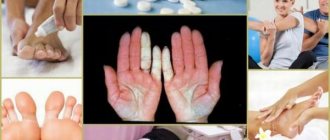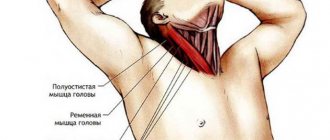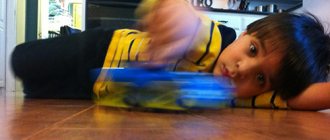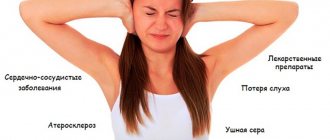Unusual sensations in the body are perceived by many as dangerous harbingers of some kind of disease. Some are harmless, such as numbness in the head that occurs after sleeping in an awkward position or due to an old injury. It’s okay if this happens occasionally, but such a symptom may also indicate some serious pathologies that are important to know about.
Causes of numbness in the head
Whatever the preliminary diagnosis, everyone has their own description of the sensations and duration of discomfort.
There is numbness of the scalp and loss of sensation above the eyebrow, in the back of the head or at the top of the skull, on the right side of the head or the left. Don't worry if it happens rarely and goes away quickly. Occasionally, the symptom of loss of sensitivity is accompanied by complications - numbness of the tongue and slurred speech. This is often how a stroke begins to manifest itself. If this condition not only does not go away, but worsens, you should not delay contacting specialists. The appearance of unpleasant sensations with a certain frequency indicates the need for a comprehensive examination.
The main causes of numbness in the head:
- circulatory disorders;
- neuroinfections;
- head injuries;
- narrowing of neck vessels;
- hypothermia of the upper body;
- uncomfortable posture during sleep;
- cerebrovascular and autonomic disorders;
- diseases of the upper spine;
- consequences of severe stress;
- bites to the neck or head from poisonous insects (spiders, centipedes);
- mushroom poisoning and other intoxications;
- treatment with certain drugs.
Often the patient is able to reliably indicate after which sensitivity disappeared. It’s worse when an unpleasant symptom occurs unexpectedly, against the background of good health.
Numbness in the head has various causes and may be accompanied by other characteristic symptoms, such as tingling or general weakness. This happens when there is narrowing of blood vessels or damage to the roots of neurons. But similar symptoms also accompany more severe diseases, such as a brain tumor.
If there are signs of concern, consult a doctor for a comprehensive examination and treatment. This is not the case when they are treated with headache pills, neck massage, applying a wet napkin to the forehead, brewing soothing herbs and various “folk” methods.
How to treat numbness or relieve pain on your own
In some cases, you can do without medical help. Knowing exactly why the back of the head or another part of the head is numb, you can take simple measures. Numbness of the head occurs and is not associated with illness. Sometimes all it takes to make it go away is:
- change your sleeping position;
- avoid stressful situations;
- do not overcool, exclude infections.
If the back of your head feels numb, just keep it warm, wrap it in a scarf or put on a warm hat, and make an alcohol compress.
Under stress, blood vessels contract, blood flow is disrupted, resulting in oxygen starvation and numbness of the head. The person feels as if his head is cramping. Hypoesthesia during stress requires relaxation, taking sedatives and vitamins.
If your head is numb, you should beware of hot food, as the sensitivity of the tongue receptors can decrease, and it is very easy to get burned.
Diagnostic methods for loss of sensitivity in part of the head
When visiting any medical institution, you will have to undergo a series of tests for biochemical parameters. They can detect iron deficiency anemia and other diseases that can be corrected with medication. When numbness of the head is accompanied by alarming symptoms, specialists prescribe a series of examinations.
The following will help confirm a particular diagnosis:
- CT scan.
- Electroneuromyography.
- Registration of evoked brain potentials.
- Electroencephalogram.
- Magnetic resonance imaging.
- Ultrasound Dopplerography of blood vessels.
- X-ray of the cervical spine.
There is no need to worry in advance if you have to undergo hardware diagnostics. This helps specialists exclude many organic lesions and nervous diseases in which the sensitivity of the upper body is reduced.
Some congenital vascular pathologies that did not appear in childhood are discovered after examination - many years later or closer to old age. After completing a course of treatment and proper massage, patients are no longer bothered by numbness in the back of the head (other manifestations).
Contact a specialist
Numbness in the back of the head or another part of the head is a signal from the body about problems in the nervous system. There are a number of additional symptoms that require mandatory qualified medical treatment:
- problems with swallowing, vision, hearing;
- slurred speech;
- dizziness, nausea, vomiting;
- numbness of the limbs, right or left side of the body;
- unsteady, shaky gait;
- involuntary urination;
- general weakness, insomnia, apathy;
- pain in the eye sockets, pain and noise in the ears;
- elevated body temperature.
We suggest you read: Swollen gums near a tooth, what to do at home. Consulting dentist
Possible lesions
You cannot diagnose yourself based on your own feelings without having a specialized education. Ingoda minor discomfort in the body indicates a serious pathology.
Some forms of oncology are accompanied by a sharp decrease in appetite and numbness of part of the head, and women rejoice at the “improvement” of their figure.
Painful sensations often indicate temporary disorders - this is cervical myositis. It occurs after hypothermia. My neck hurts when I turn my head to the side, and the back of my head goes numb. Some patients are wary of this symptom, believing that they are “paralyzed.”
Neurologists tell many cases when particularly suggestible patients treated the diagnosis with distrust, preparing themselves “for the worst.” Others were frivolous about the oncological diseases discovered in them, which were detected during hardware diagnostics of numbness in the head.
It is useful to monitor your feelings, but without excessive suspiciousness. It is recommended to complete any course of treatment without going to extremes.
Growing tumors of the nervous tissue, head or cervical spine put pressure on neighboring tissues. Their displacement and compression also leads to loss of sensitivity. Remember that cancer in its early stages is curable, so if warning signs appear, do not delay visiting your doctor.
Facial nerve neurosis
Neuritis (neurosis N. Facialis) or Bell's palsy occurs due to inflammation of the nerve fiber. Reasons leading to this condition:
- pinched nerve as a result of narrowing of the channel through which it passes. This may be a congenital phenomenon or result from inflammation;
- hypothermia;
- other diseases and infections: herpes, mumps, otitis media, stroke, cancer, central nervous system infections;
- injury N. Facialis.
The onset of the disease is usually gradual. Manifested by pain in the behind-the-ear area. After a couple of days, neurological facial symptoms appear:
- smoothing of the nasolabial fold, drooping of the corner of the mouth;
- the face becomes asymmetrical with a skew towards the healthy side;
- eyelids do not droop. When you try to do this, your eye rolls;
- any attempt to show at least some emotion ends in failure, since the patient cannot move his lips, smile, or manipulate his eyebrows. Such manifestations can worsen to the point of paresis and paralysis of the facial muscles, that is, to partial or complete immobility of the affected part of the face;
- taste sensitivity decreases, salivation appears;
- the eyes are dry, but there is lacrimation when eating;
- hearing on the affected side worsens.
We suggest you watch Tonsil stones video
The severity of pathological symptoms depends on the degree and area of damage to the nerve fiber. If the disease is treated inadequately, complications may arise in the form of muscle contractures (immobility).
Since the disease is inflammatory in nature, its treatment is aimed at eliminating it. For this, the patient is prescribed hormonal anti-inflammatory drugs - glucocorticoids, as well as decongestants.
Other methods include:
- prescription of vasodilators and analgesics, B vitamins;
- anticholinesterase agents to increase nerve conduction;
- drugs that improve metabolism in nervous tissue;
- physiotherapy;
- massage, exercise therapy in the recovery stage.
And only in extreme cases, when conservative therapy is ineffective, neurosurgical intervention is resorted to.
Manifestation of neurological and other diseases with accompanying numbness
The source of the lesion may not be where the loss of sensation is. Only a specialist can determine where the pathology is. With numbness in the back of the head, manifestations of osteochondrosis are possible, leading to increased intracranial pressure. Not only vascular pathologies, but also nervous ones manifest themselves in this way. But there may also be psoriasis in the scalp. At the initial stage, it is regarded as “just dandruff”.
Damage to nerve endings that have the same symptoms is a consequence of the degenerative process of the cervical vertebrae. This happens due to their displacement, hernia or protrusion.
Inflammation of the trigeminal nerve leads to loss of sensation in half of the face, most often on the left side. Each pair covers 3 branches:
- maxillary;
- orbital region;
- mandibular
The source of damage should also be looked for in the cerebral sphere: neuroinfection, transient ischemic attack, stroke. Such a stimulus often transmits impulses from the affected brain to the opposite hemisphere.
Experts with numbness on the left side of the head suggest that the pathology is localized in the right hemisphere and vice versa.
Doctors pay attention to the accompanying symptoms of numbness:
- temperature increase;
- decreased functionality of the limbs;
- speech disorder;
- headache;
- facial asymmetry, etc.
Temporary loss of sensitivity due to sitting for a long time at a computer or laptop, sleeping on an uncomfortable surface or exercising on a hard exercise machine is not dangerous.
Representatives of sedentary professions in adulthood are often diagnosed with osteochondrosis. It can lead to pinched nerves, compression of blood vessels, causing high blood pressure - this is a prerequisite for a stroke. Examination, massage, physiotherapy and drug treatment of osteochondrosis will cost less than treatment of a stroke with paralysis and disability.
Multiple sclerosis, as a result of the replacement of nervous tissue with connective tissue, is practically incurable. But early diagnosis of serious diseases with symptoms of numbness of the head makes it possible to alleviate them and delay the onset of severe complications.
Fever
Increased body temperature (above 38°C) can cause headaches and other symptoms (in particular, with a fever, the scalp becomes numb and stiffness in the back of the head appears). For this reason, it can sometimes be difficult to distinguish a relatively common infection from meningitis.
Causes:
- infectious diseases;
- autoimmune disorders;
- tumor processes;
- increased thyroid function;
- complications of transplantation and transfusion;
- tissue damage;
- intoxication with drugs and other substances;
- heatstroke;
- malignant hyperthermia.
When you can’t do without urgent medical help
Emergency medical care is required by patients whose numbness not only does not go away within 2-3 hours after sleep, but is also accompanied by alarming symptoms. Referring patients to specialists to diagnose brain pathologies increases the likelihood of preventing severe complications.
If numbness (with tingling and other unpleasant sensations) recurs with some frequency, the health problem should not be left to chance. Numbness in any part of the head can lead to dizziness or drowsiness. In some cases, this leads to loss of orientation in space, loss of strength and fainting in the office or other crowded place. If this happens, you cannot postpone calling an ambulance and visiting a doctor.
In rare cases, numbness of the head has other unpleasant “companions”, such as disruption of the musculoskeletal system, nausea and vomiting without symptoms of poisoning, drowsiness and general weakness, impaired control of urination and bowel movements. You should not consider these sensations separately; it is possible that there is a serious illness.
How to get rid of nervous tics
In order to free yourself from unpleasant sensations, you must first eliminate their problem. Sometimes all it takes is a good night's sleep. In another case, you need to change the situation for a while, get out of the destructive environment.
Among the auxiliary methods used are herbal soothing teas, baths with the addition of aromatic oils, swimming, walks in the fresh air or sports: running, yoga.
Add ingredients with a high content of calcium and magnesium to your menu. These include fermented milk products, buckwheat, bran bread, red fish, eggs, and meat. Vegetables and fruits include beets, currants, dried fruits, nuts and parsley.
If these foods do not fit into your diet, consider taking appropriate vitamin supplements. Do not overuse strong tea and coffee.
And most importantly: remain optimistic and calm in any situation!
In cases where the condition worsens, psychotherapy is sought. Cognitive behavioral therapy is especially effective in helping to stop tic disorders at the stage of their precursors.
Habit reversal therapy teaches patients movements that help prevent the development of neurological facial symptoms.
Medications include anticonvulsants and muscle relaxants, Botox injections, and antidepressants.
If the above methods are ineffective in combating nervous tics, they turn to deep brain stimulation. A device is installed in the GM that controls electrical impulses.
Recommendations
If you intend to determine why your head is numb, then first of all you will be prescribed studies aimed at determining the root cause.
In acute or complicated forms of the disease, rehabilitation can be quite lengthy, but it cannot be avoided, because otherwise complications may arise and the patient’s condition will only worsen. Without proper attention to the problem, even death is possible.
With this disease, the patient should behave carefully and not approach sources of fire, do not eat too hot food, since the disease can weaken some receptors and it will end in a burn. You should also avoid situations in which an attack of hypoesthesia begins, since the intensity and duration of the attack can directly depend on external circumstances.
Preventive measures
The main measure to prevent vascular pathologies is a healthy diet and regular exercise.
To avoid the development of atherosclerosis, it is necessary to minimize the consumption of refractory animal fats (pork, lamb) and trans fats - liquid vegetable fats artificially converted into a solid state. The daily diet should contain enough clean water, vitamins and polyunsaturated fatty acids. They are found in large quantities in sea fish, cheese, nuts, and vegetable oils.
To reduce the likelihood of developing hypertension, you should stop smoking and minimize alcohol consumption. Daily walks in the fresh air, avoiding stress and emotional turmoil are useful.
In the prevention of inflammatory processes, personal hygiene and immune support play a major role. Vitamins and microelements will help you provide good anti-infective protection; during the cold season, you can resort to taking immunostimulants. But such drugs must be used wisely, only after consultation with an immunologist.











